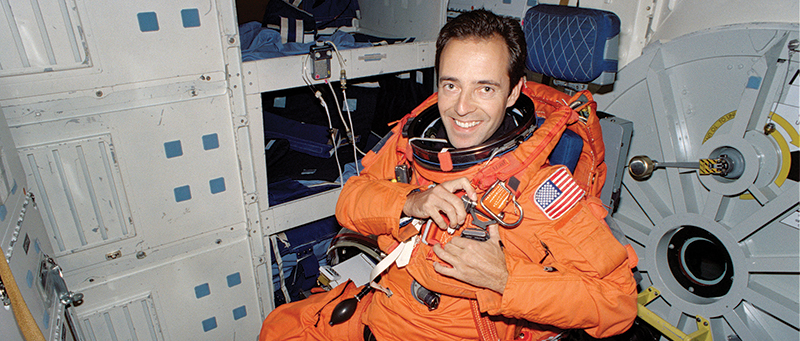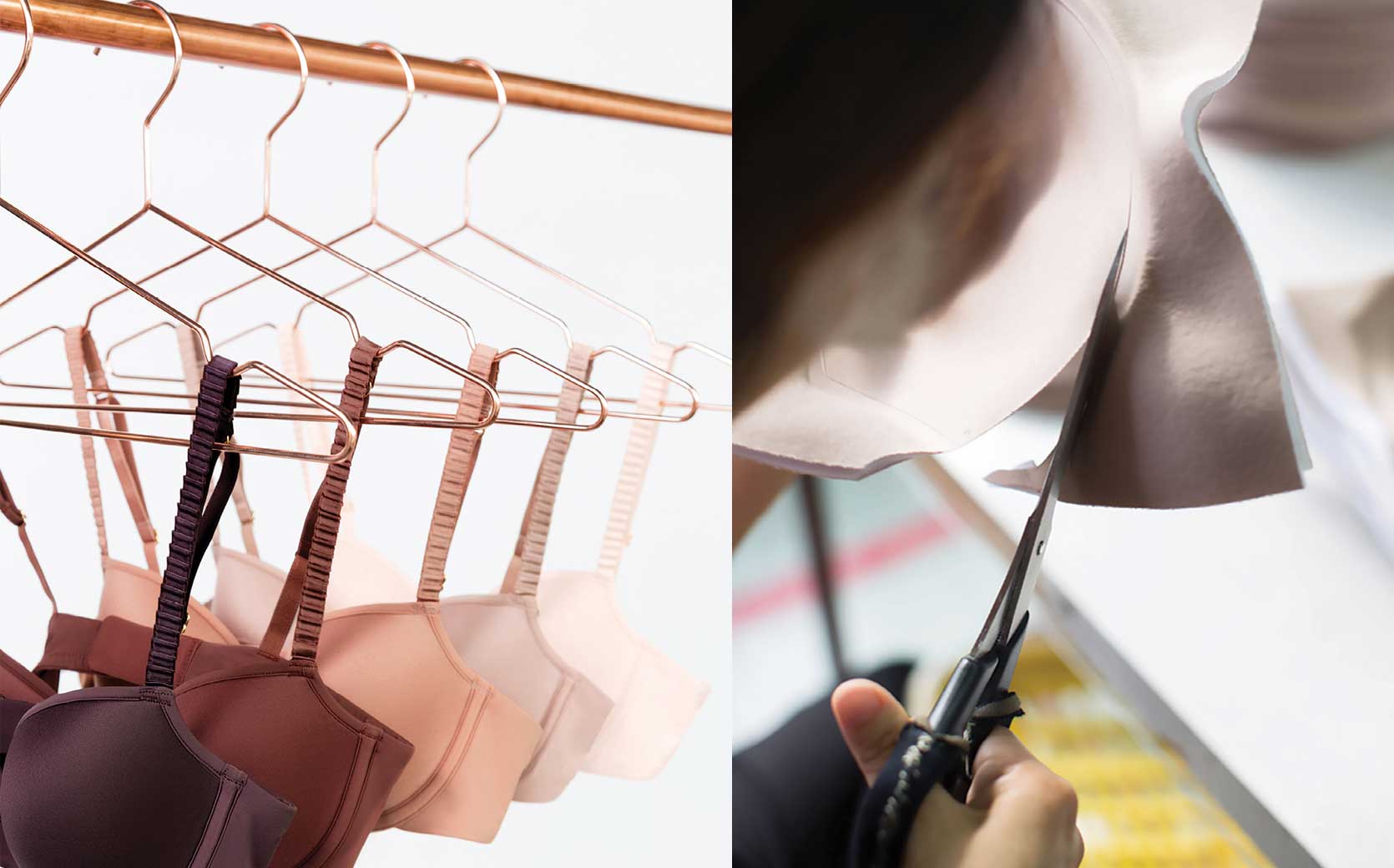
Memory Foam Supports and Shapes in Women’s Apparel
NASA Technology
If there’s one NASA spinoff that is almost guaranteed to have touched your life, it is memory foam. Even traditional spring mattresses typically have a layer of it these days, and the material is showing up in more and more unexpected items, from sneakers to car seats and even high-end bras.
But first the famously cushy foam was made for NASA, as part of a project to design safer seating for commercial airplane passengers.
It was the late 1960s, and commercial air travel was just starting to become more common. NASA, tasked with innovating in aircraft as well as spaceships, was looking for ways to improve safety in the event of a catastrophic emergency.
“At first, they were thinking of contracting for a study of a system that, if the plane was going to crash, it would blow off both the wings and have parachutes deploy off the top of the fuselage,” explains Charles Kubokawa, now retired from Ames Research Center, where he was then a human factors engineer and later held several roles including assistant administrator.
But that proposal was quickly squashed. “Top administrators said, ‘No, we don’t want to shock passengers about the possibility of a plane blowing off the wings,’” Kubokawa recalls with a laugh.
So he and his team decided on a different plan. “We decided to design a crash-proof seat,” he says, something that would protect a passenger even in an extremely rough landing.
The project, which reimagined everything about airplane seating, from the bolts attaching it to the interior aircraft flooring to the placement of the tray table, was a success. “We developed a chair that worked real nicely for up to 36 Gs of crash worthiness,” he says, referring to forces equivalent to 36 times Earth’s gravity—well beyond the 14 Gs the rest of the plane was built to survive.
The impact protection came from a combination of design elements, but one of the most important, Kubokawa recalls, was the foam cushion they integrated into the seat and back. The design called for something that wasn’t flammable, would be comfortable, and most importantly could absorb high impact.
“We called it temper foam,” Kubokawa says. “Once you sat on the foam, it conformed evenly with the contacted body surface and made you settle snugly into the seat. After you stood up from the seat, the foam would revert back to its original form with nothing on it.”
And the foam also did a remarkable job of absorbing impact, something the team initially tested in a somewhat unorthodox way: “We put a piece of foam on the ground, and we dropped an egg on it and the egg didn’t crack. And then we dropped heavy things, and it absorbed the G forces. Any kind of fragile things that were dropped on it didn’t break.” The team also did an official proof-of-concept crash test with an anthropometric dummy at the Civil Aeronautics Medical Institute in Oklahoma City, resulting in acceptable positive results.
Although the seats were never fully integrated into commercial jets, the original temper foam has found a wide range of uses, a payoff the inventors were quick to anticipate—and in fact, the engineer who worked with Kubokawa, Charles Yost, later became one of the first commercial manufacturers.
Technology Transfer
The first prototype of the NASA-designed airplane passenger seat used a different, pre-existing foam, but it had a critical flaw: it was flammable.
When the NASA team realized it needed to go back to the drawing board, Kubokawa went back to the seat designing company, Stencel Aero Engineering Corporation. There, he worked closely with Yost to design a new foam formula that would meet the project’s needs. “Yost had the chemistry background” and was doing the actual mixing and fabricating, Kubokawa says, “but a lot of it was a hit-and-miss type of thing. There were many iterations of the foam composition, and he and I discussed what changes had to be made.”
After the successful version was completed and detailed to NASA, Yost went into business for himself, opening Dynamic Systems Inc. in 1969. Besides airplane seats, Yost’s company extended the uses of memory foam to a number of industries, including making a line of cushions that could be used in orthopedic seating and mattress pads to reduce the risk of bedsores and seat sores for wheelchair patients (Spinoff 2005).
But neither Yost nor Kubokawa ever patented the innovations pioneered in the seat, in part, Kubokawa says, because of a snafu that happened when he went away on vacation: while he was away, a public affairs colleague showed a reporter the ongoing project, allowing the reporter to take pictures that were later published.
U.S. patent law requires that a patent be filed within a year of an invention first getting written about publicly, and Kubokawa, unaware of the newspaper article published during his vacation, missed that deadline. “The patent officer came to my office and said, ‘I hate to tell you this but you’re one day after the year limit.’”
As a result, the foam, along with 26 other potentially patentable innovations, were never patented. In the 1980s, NASA released the formula for temper foam into the public domain, paving the way for many companies to use it in a variety of industries and consumer goods.
Benefits
When ThirdLove began designing a modern, high-end bra, the San Francisco-based company wanted to start from the ground up. “Part of that is, we don’t come from the traditional apparel industry, so when we decided to go into the market, we took a very Silicon Valley-like approach: how do we build a better company, a better system, a better product?” explains cofounder David Spector.
One of the areas they focused on, he says, was the foam layer that gives the cup its shape. “Memory foam really does form to your body like a second skin,” notes design chief Ra’el Cohen. Unlike other foams that are stiffer, memory foam softens with body heat, allowing for a shape that conforms to the body instead of the other way around.
Once the company settled on memory foam, however, it still needed to innovate: after all, the thick, heavy pad that works in mattresses would never do for a bra. “We knew we wanted to do something that was kind of revolutionizing the way memory foam was used,” Cohen says. “We wanted a thinner pad but also needed it to be supportive enough.”
The solution they found was to tweak the foam formula to make it lighter, less dense, and able to be cast in a very thin sheet. Then, unlike other bras, which use a separate foam pad between two layers of fabric, the company laminates the nylon fabric directly to the foam using a heat process. That adds extra structure to the foam, ensuring it is supportive enough while also minimizing the total amount of material and layers in the final garment.
“All of our bras in our collection have memory foam,” Spector says. “It’s something that ThirdLove has built the collection around—we find customers really love it.”
Although their products don’t need the high-force impact protection that memory foam was originally created to provide, the company did appreciate the NASA history behind the technology.
“It’s a wonderful technology, and there’s a lot of credit that goes to NASA for developing it,” Spector says. “It’s done tremendous things to enhance products across the board. And now, we’re really proud to be bringing it to the bra category.”

Today, memory foam is one of NASA’s most widely used spinoffs. The material turns up in everything from mattresses to wheelchairs to protective gear—and even bras. ThirdLove adapted the material to enable it to be cast in thin layers for a bra that molds comfortably to the body while offering the right level of support.

Memory foam, also known as temper foam, was originally created for a project to improve passenger seats for airplanes, but the extraordinary impact absorption of the material ensured it was soon used for many other projects, including seats on the Space Shuttle.













